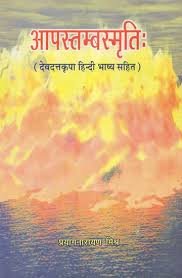Apastamba Smriti
Āpastamba Smriti

The Āpastamba Smriti is one of the 18 principal Dharma Smritis and is attributed to Sage Āpastamba, who is also known for his contributions to the Āpastamba Śrauta Sūtra and Gṛhya Sūtra. Belonging to the Kr̥ṣṇa Yajurveda tradition, this Smriti is considered one of the older and more systematic texts on dharma, though it is more concise compared to Manu or Yājñavalkya Smriti. Composed likely between the 3rd and 5th century BCE/CE, it is written in sutra style rather than verse, giving it a compact, aphoristic format suitable for memorization and teaching. The text primarily focuses on Vyavahāra (law and judicial procedures) but also includes rules for Ācāra (conduct and rituals) and Prāyaścitta (penances), making it a complete Dharmaśāstra.
The content of the Āpastamba Smriti covers a wide range of subjects. It deals with duties of the four āśramas (stages of life), marriage rules, inheritance laws, property distribution, contracts, debts, disputes, criminal law, and judicial procedures, including the proper conduct of courts, role of judges, and methods of evidence. A major emphasis is placed on Vyavahāra, making it particularly significant as a practical legal manual. It also addresses Prāyaścitta, prescribing penances for intentional and unintentional violations of dharma, along with ethical guidance for householders and ascetics. The text is notable for its clarity, systematic approach, and logical organization, which later influenced other Dharmaśāstras, including Yājñavalkya Smriti and the Mitākṣarā commentary tradition.
In terms of significance, the Āpastamba Smriti has been highly respected in the history of Hindu law. Medieval digest writers frequently cited it as an authority in inheritance, contracts, property disputes, and penances. Its emphasis on judicial procedure and proper conduct of courts reflects the sophistication of ancient Indian legal thought, bridging the gap between moral law and practical governance. Today, it is studied as a foundational text for understanding early Hindu legal principles, social conduct, and the integration of law with dharma, showing how ancient society sought to harmonize justice, ethics, and spiritual duties.
What makes Āpastamba Smriti particularly notable is its focus on judicial procedure and practical law. The text lays down rules for how courts should operate, the duties and qualifications of judges, the role of witnesses, and the use of written and oral evidence in trials. It addresses civil matters like contracts, debts, partnerships, and property disputes, as well as criminal acts and appropriate punishments, reflecting a sophisticated understanding of law and governance. Compared to Manu or Yājñavalkya Smriti, Āpastamba Smriti is more concise and technical, providing practical guidance to rulers, judges, and householders rather than moralistic or philosophical elaboration. Its influence on later Hindu law is profound: medieval digest writers cited it frequently, especially on inheritance, property, contracts, and court procedure. Today, it is valued as a foundational text demonstrating the early integration of ethics, law, and social governance, showing how ancient Indian thinkers sought to maintain justice, order, and dharma in society.




















































